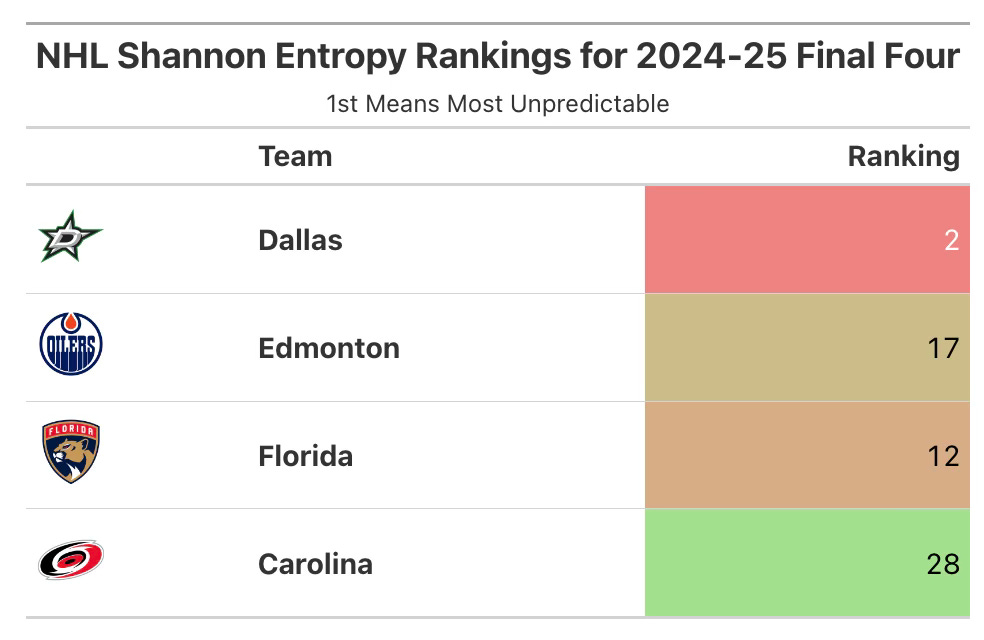Is It Better for a Hockey Team to Have a Superstar or Depth?
Using Shannon Entropy to Determine What Makes Up the Most Dangerous Offenses
Not every hockey team can be like the Edmonton Oilers and have both Connor McDavid and Leon Draisaitl but also superb linemates like Ryan Nugent-Hopkins and Zach Hyman. They boast two of the bigger superstars in the sport while supplementing their efforts with depth that most any other hockey team would love to have.
Must be nice.
For nearly everyone else, though it often never works out this way, let’s pretend a front office has to make a difficult decision: pay a superstar what he is worth or use those resources to acquire and develop depth at the cost of not having that one standout skater. There are sound philosophies to both approaches. On the one hand, a superstar could be so effective scoring that no goaltender could stop anything he shoots. On the other hand, several decent scorers could make gameplanning more challenging for the opposition to where they do not know who to take out of a play or how to handle shuffled line changes.
One way to explore this question is by using a technique I have previously discussed at length: Shannon entropy. For those yearning for a refresher, this approach measures the uncertainty of a variable, as part of information theory. As new information about a variable is transmitted, probabilities are communicated as well based upon how surprising or rare that information is. In other words, variables with a 50-50 chance of some binary outcome occuring are considered more unpredictable, and these results have a higher entropy. However, when we can safely gauge what will happen with an outcome, we come up with a lower entropy.
Our purposes involve who is manufacturing the shots likeliest to lead to goals. However, any analysis involving goals is tricky because they are rare events compared with shots and most anything else in hockey. Goals can also happen because of circumstances having nothing to do with the shooter; meaning a goalie could goof and allow an easy shot through, or the puck can bounce off something random like a skate and sneak in. Fortunately, expected goals, which assign a probability to every shot that it will lead to a goal, provide a larger sample size of hockey events and are less affected by things out of the shooter’s control. A glance at any expected goals leaderboard from any hockey website will have the usual suspects the leading the way like Auston Matthews, Mikko Rantanen and Zach Hyman.
Let’s look at just the last regular season and analyze the entropy of expected goals for each hockey team only in 5-on-5 situations so that power play frequency and ability do not inflate someone’s expected goal marks. Then’s let’s compare those marks with how many goals they actually scored:
This graph only includes skaters who played at least 500 minutes that season for their particular hockey team. This minimum is so that a team doesn’t naturally have more entropy because of things like trades or injuries. What matters most is this: the farther teams are to the right of the graph, the more evenly distributed and less condensed those expected goals are among skaters.
The red regression line tells us there is an inverse relationship between these two factors, meaning the more unpredictable expected goals come from, the fewer goals are scored1. Given these findings, one could claim it’s better to have a superstar or two instead of depth because those few are likelier to generate a higher shot quality and more goals than a bunch of less talented players.
Last season, Edmonton featured the most predictable offense with the lowest Shannon entropy. The Florida Panthers had the 14th-highest, and they won the Stanley Cup. Condensing high-quality shots may not guarantee success. More seasons should be analyzed to get a better feel of this metric’s importance. So, let’s look at the last five years to see the Shannon entropies of the last two teams standing in each season2:
Four of the last five Stanley Cup champions and three of the last five runners-up were roughly in the middle of the pack in Shannon entropy rankings or closer to the spectrum where they are superstar driven. The only real successful exception is Vegas when Jonathan Marchessault, William Karlsson and Mark Stone almost perfectly split a combined 35 playoff goals evenly. Regardless, there may be more of a balancing act between having a superstar and exclusively role players, erring slightly on the side of superstar.
As for this season, with four teams remaining, here are their Shannon entropy rankings:
As perhaps expected, the two hockey teams leading their series rank in the middle of these unpredictability scores. Edmonton’s superstars are household names, but Florida has boast having Aleksander Barkov and Sam Reinhart (despite his injury), and Carolina features Seth Jarvis and Andrei Svechnikov.
What’s perhaps most interesting is while the Dallas Stars were sharing the wealth during the regular season, their playoff run has largely been about one skater: Mikko Rantanen. His production has tapered off since Game 5 of the Second Round against Winnipeg, where he’s only notched two assists and no goals in that five-game span. Rantanen will have to be elite again if Dallas is to come back in that series. If you believe he will, a same game parlay of him to tally a goal and for the Stars to win outright may be your best approach. He can play like a superstar, and as we’ve learned, usually the best offenses have one.
The p-value of 0.026 is significant with 95% confidence.
Because of COVID shortening the 2019-20 and 2020-21 seasons, the minimum time on ice requirement was reduced to 400 minutes.






